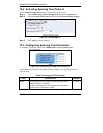
Dimension ES-2008 Ethernet Switch
Spanning Tree Protocol 10-1
Chapter 10
Spanning Tree Protocol
This chapter describes the basics and configuration of STP.
10.1 Introduction
Spanning Tree Protocol) is a standardized method (IEEE 802.1D) that eliminates loops in
a network by disabling some ports and allowing other ports to forward traffic based on the
parameters you configured. STP ensures that there is only one path between a specific
source and destination so packets will not travel in loops.
STP provides path redundancy while preventing undesirable loops in the network. STP
detects and breaks network loops and provides backup links between switches, bridges or
routers. It allows a device to interact with other STP-aware devices in your network to
ensure that only one path exists between any two stations on the network.
The root bridge is the base of the spanning tree; it is the bridge with the lowest identifier
value (MAC address). Path cost is the cost of transmitting a frame onto a LAN through
that port. It is assigned according to the speed of the link to which a port is attached. The
slower the media, the higher the cost. Refer to the following table for the recommended
path cost (in the allowed range between 1 and 65535) for each link speed.
Table 10-1 Recommended Path Cost
LINK SPEED RECOMMENDED VALUE RECOMMENDED RANGE
4Mbps 250 100 to 1000
10Mbps 100 50 to 600
16Mbps 62 40 to 400
100Mbps 19 10 to 60
1Gbps 4 3 to 10
10Gbps 2 1 to 5
On each bridge, the root port is the port through which a bridge communicates with the
root. It is the port on this switch with the lowest path cost to the root (the root path cost).
If there is no root port, then this switch has been accepted as the root bridge of the
spanning tree network.


















